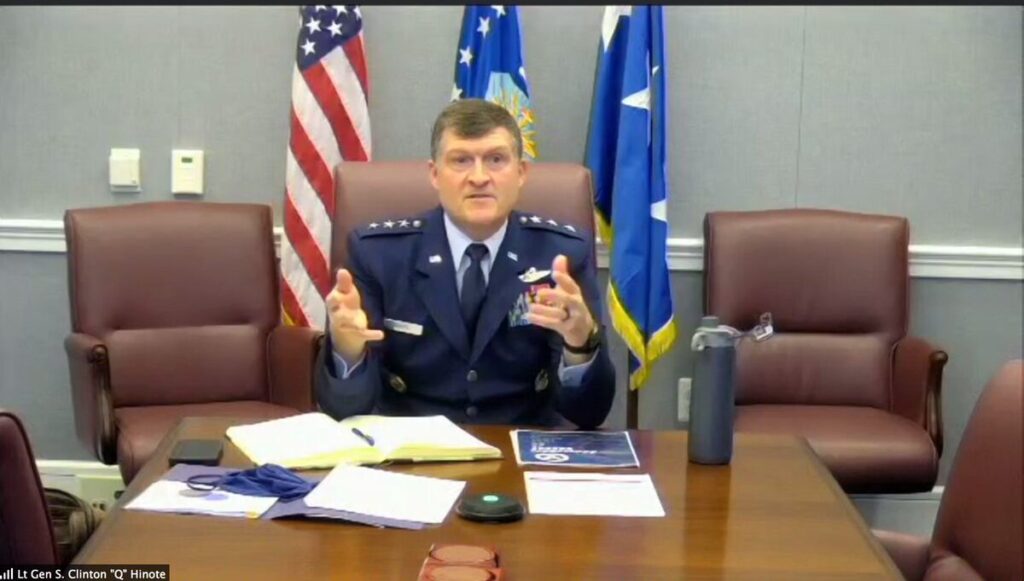By THERESA HITCHENS
Lt. Gen. Clinton Hinote
 WASHINGTON: DoD and Congress must find new ways to work together on acquisition of capabilities for future All-Domain Operations, says Lt. Gen. Clinton Hinote, the Air Force’s requirements guru.
WASHINGTON: DoD and Congress must find new ways to work together on acquisition of capabilities for future All-Domain Operations, says Lt. Gen. Clinton Hinote, the Air Force’s requirements guru.“We have got to come up with a compromise with the people’s representatives when it comes to defining requirements in the future,” he told the West Coast Aerospace Forum in a panel discussion released online today. The annual West Coast forum, sponsored by RAND, the Mitchell Institute, the Center for Strategic and International Studies, the Aerospace Corporation, and MITRE, is usually held in Los Angeles, but went virtual this year due to the pandemic.
Hinote — whose official title is Air Force deputy chief of staff for strategy, integration and requirements — said that in many ways it’s understandable that Congress is skeptical about the lack of specific requirements for Joint All-Domain Command and Control (JADC2) and the Air Force’s Advanced Battle Management System (ABMS). This is because the iterative process necessary for developing Internet-like capabilities for managing All-Domain Operations is simply not compatible with the much slower cycle of the annual budgeting and oversight processes.
Because of the way the Pentagon crafts its annual five-year budget submission to Congress, he said, “you’re really talking about plus or minus eight years, and there would be almost no technology company that would feel good about what happens in five years.”
But, that said, Hinote stressed, “It is absolutely critical that the Congress has proper oversight over things like the buying of the ABMS system and any other system that that we might go purchase. … Second, it’s going to be really hard for us to say what we’re going to spend money on an eight years. So let’s figure out a way that we can have an iteration with Congress, i.e., maybe we can come over and talk to them every three months.”
“We’re going to have to figure that out as a team,” he said.
This is going to be crucial as the Pentagon begins to speed up development and acquisition JADC2-related technologies and capabilities in 2022 and 2023, he said, following the year-end completion of the Joint Warfigthing Concept. Hinote explained that the Joint Force commanders are now eager to employ the nascent capabilities emerging to enable JADC2.
“A year-and-a-half ago, we were just trying to get in the door talking about command and control across the Joint Force. We were competing against many other things. And now there’s widespread agreement, to include in the JROC [Joint Requirements Oversight Council], that this is the most critical thing we are going to do as a Joint Force to make ourselves more capable, and that’s a major movement,” he said.
“This idea that you’re going to be almost totally agnostic as to where the sensing comes from; you’re going to be almost totally agnostic as to where the effects come from and you’re going to be pretty agnostic as to where the decisions are made … that’s going to be revolutionary,” he added.
Over the next year, Hinote said, the focus of the JADC2 effort will be primarily on development “gateways and translators” to connect legacy systems across the services. This is what is at the heart of ABMS, the Army’s Project Convergence and the Navy’s Project Overmatch, he said. Those somewhat disparate efforts are “all going to come together because they have to,” he added. “We know they have to.”
As Breaking D readers are aware, Air Force Chief of Staff Gen. Charles Brown and his counterpart Gen. James McConville on Oct. 2 signed an agreement to link the ABMS and Project Convergence experiments, and, perhaps most importantly, to develop common standards and interfaces for sensors and weapon systems. But, as Paul reported earlier this month, the Navy has been somewhat loathe to integrate its Project Overmatch with the Army and Air Force efforts.
Tim Grayson, head of DARPA’s Tactical Technology Office, agreed that for legacy systems, gateways that provide connectivity will be the right answer. But even for future systems, he cautioned, there will never be “global standards” across DoD for specific functions, even those that are software defined.
“From a technology side of things, programs are built to do certain specific functions,” he said. “And then you get into the programmatic realities of all of these different programs that are going to be doing recap[italization] and doing modernization on different timeframes and different scales. … We are always going to be in a highly heterogeneous environments, okay? And so the answer is going to be, how do we work in a federated manner?”
Grayson explained that “what we really want are standards systems that are built with a well-defined, clear interface to some kind of standard. It makes this job of on-demand interoperability, much, much, much simpler.”
This is the reason DARPA is looking beyond JADC2 to an even more connected modus operandi for conducting warfare, he said, dubbed Mosaic Warfare. That concept is essentially JADC2 on steroids, where military operations are put together on the fly from combos of available sensor, shooter and communications systems via the use of artificial intelligence algorithms.
“Where we are today is what I like to think of as wave one of JADC2, so it is this fundamental shift in how we think about warfighting from the monolithic platforms to the distributed kill chains,” Grayson said. “Where we’re focusing on at DARPA is what I think of as wave two.”
No comments:
Post a Comment